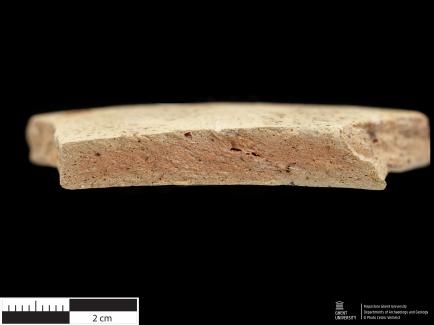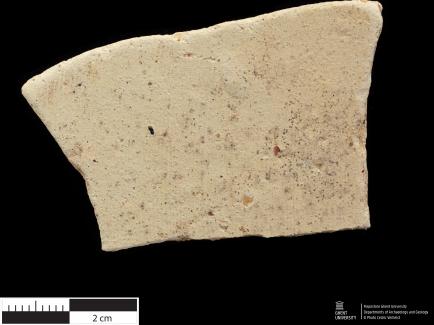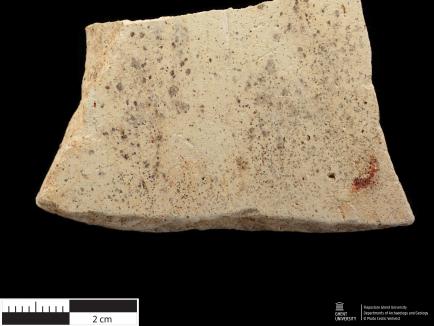Post Medieval - Tin glazed (majolica & faience) (7.TG.BE.0017)
Hand specimen pictures (macro & binocular)
Thin section pictures
Find location
- Category
- Tin glazed (majolica & faience) (Post Medieval)
- Fabric name
- biscuit
- Chronology
- Post Medieval > Modern > 1556-1561/1562
- Dating method(-s)
- historical sources, typology, iconography
- Potters' mark
- No
- Additional information
- biscuit waster (wall fragment); referred to as "rough fired ware"
Find location
- Site type
- Pottery production
- Location
- Belgium; Antwerpen; Antwerpen
- Site name
- Antwerpen, Steenhouwersvest
- Excavation or Survey Team
- Afdeling Opgravingen, Stad Antwerpen
- Additional contextual information
- site code: A117; context information: A117/7/x56; excavation 1993 (kiln + production waste); attributed to the workshop/pottery company of Lucas Andries (atelier De Goudbloem)
- Surface color
- beige
- Surface texture
- Smooth
- Fracture color
- pink with beige/weith layers
- Inclusions (non-plastics/tempering)
- quartz; iron oxides (?); amorphous and oval red and beige inclusions (clay pellets ? grog ?); rare black inclusions (?)
- Matrix and voids
- vughs and vesicles; badly mixed clay (layers of white/beige clay within pink matrix)
- Diagnostic features
- Additional information
- sample ANTW_SV_ST1a
- Flepostore inventory nr.
- ARCH1.L1.C8a
- Original inventory nr.
- A0049
- Collection
- Archaeological Department, Ghent University
- Type
- Covered thin section
- Comparable thin section(s)
- Matrix
-
Oxidised light orange fabric; dark brown (PPL), dark brown (XP).
Homogenous matrix, non-calcerous with no optical activity: matrix near sintering/vitrification due to overfiring.
- ca. 75-85% - Inclusions
-
Quartz (++; mono++, poly--), sedimentary rock detritus (-; quartz arenite), chert/flint (-; ff), metamorphic rock detritus (-, low grade), feldspars (-; plagioclase, orthoclase), muscovite mica (-; el), glauconite (--; uncertain, red body color); O/Fe (+), clay pellets (+-; iron-rich).
The coarse fraction consists of medium to coarse sand, the fine fraction consists of very fine to fine sand, possibly bimodal (natural). Grains are generally subrounded to subangular/angular. Overall the fabric is poorly sorted and poorly orientated, single to open spaced.
- ca. 10-20% - Voids
-
Some larger vughs, poorly aligned, some infill.
- ca. 5% - Diagnostic features
- The fabric is characterized by a homogenous oxidised matrix with no optical activity (overfired: partly vitrified) and low porosity. Dominant quartz inclusions with frequent opaques/iron oxides, common iron-rich clay pellets, few sedimentary and metamorphic rock detritus, chert/flint, feldspars, muscovite mica, and rare possible glauconite. Overall poorly sorted fabric.
- Additional information
-
Mineralogical information lost from misfiring.
*Matrix is overfired near sintering/vitrification, yet some possible glauconite grains have retained a red body color. Possible indication of overfiring due to a too long duration of firing rather than too high temperature?
**Iron-rich clay pellets appear brown to black also possible related to misfiring conditions.
- Sample type
- Pottery
- Inventory number
- 7.TG.BE.0017
- Collection
- Archaeological Department, Ghent University
- Donating institute/person
- Onroerenderfgoeddepot, Stad Antwerpen
- Host collection
- Onroerenderfgoeddepot, Stad Antwerpen
- Other samples available
- No
- Sample collection method
- Archaeological Excavation
Dumortier & Veeckman 1994
- Full reference
-
Dumortier C. & Veeckman J. 1994. Un four de majoliques en activité à Anvers vers 1560. Bulletin van de Koninkljke Musea voor Kunst en Geschiedenis. Jubelpark Brussel 65: 163-217.
Veeckman 1994
- Full reference
-
Veeckman J. 1994. Een majolica-oven aan de Steenhouwersstraat te Antwerpen (Antw.). Archaeologia Mediaevalis 17: 5-7.
Cite this page as: Flepostore - https://flepostore.ugent.be/ceramics/7-tg-be-0017
Last modified: 2024-04-27.





